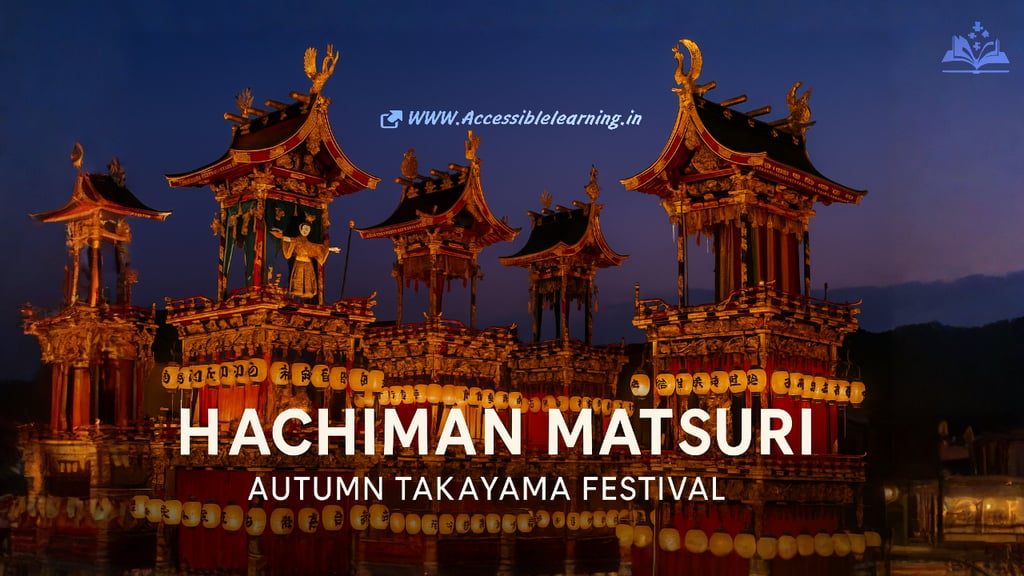
Hachiman Matsuri (Autumn Takayama Festival) — Dates, History, Floats & Visitor Guide
Discover the Autumn Takayama Festival (Hachiman Matsuri): history, the spectacular yatai (floats), karakuri puppet shows, the night lantern parade, practical travel tips, and local etiquette to make the most of your visit.
CULTURE/TRADITIONEVENT/SPECIALTRAVEL LIFECELEBRATION/FESTIVALS
Kim Shin
10/3/20253 min read


Hachiman Matsuri, commonly called the Autumn Takayama Festival, is one of Japan’s most beautiful autumn shrine festivals. Held around Sakurayama Hachimangu (Hachiman) Shrine in Takayama, Gifu Prefecture, the festival centers on a parade and display of ornately decorated festival floats (yatai) and traditional mechanical puppet (karakuri) performances. It is the autumn counterpart to the spring Sanno festival and is locally known for its craftsmanship and atmospheric evening lantern parade.
Short history & cultural importance
Takayama’s two main festivals (spring and autumn) date back to the Edo period and reflect the region’s rich guilds of artisans—woodcarving, lacquer, metalwork, and textile crafts. The yatai float, and their interior ornamentation displays artisan techniques passed down for centuries; several floats and marionette shows are considered important cultural assets. The festival evolved as both a Shinto celebration for good harvest and a public showcase of local craftsmanship.
What to expect: the main highlights
Yatai—the spectacular floats
The festival’s centerpiece is a fleet of ornately decorated yatai. The Autumn (Hachiman) festival typically features 11 floats, each representing a neighborhood and richly carved, lacquered, and embroidered. During the day the floats are displayed and paraded; by night they are illuminated with dozens of traditional chochin lanterns, creating a luminous, almost theatrical scene.
Yoimatsuri—the evening (lantern) parade
On the night before the main day (commonly the 9th evening when the festival falls on the 9th–10th), the floats are lit with around a hundred lanterns each and moved slowly through the streets—this night parade (yoimatsuri) is often the most atmospheric time to experience the festival.
Karakuri ningyō—mechanical puppet performances
Several floats stage karakuri (mechanical marionette) performances. These puppets—some centuries old—move via a combination of strings, push-rods and gears and can perform surprisingly lifelike dances and tricks. The karakuri displays are a major draw for culture and mechanism enthusiasts. (Smithsonian and Japanese festival sources provide great close-ups of these “proto-robot” performances.)
Takayama Matsuri Yatai Kaikan (Float Exhibition Hall)
If you want up-close access to the floats outside festival days, the Yatai Kaikan (Festival Floats Exhibition Hall) displays several of the autumn floats and explains their history and craftsmanship—a perfect stop to appreciate the detail without the crowds.
Typical schedule & dates (what to book for)
Typical festival days: the Autumn Takayama Festival is generally held on October 9–10 (with the night procession on the evening of the 9th in most years). Exact annual dates may vary slightly; check local Takayama or Hida tourism pages when planning.
Day 1 (Evening / Yoimatsuri): Lantern-lit floats, evening processions, lively streets.
Day 2 (Main day): Daytime float procession, karakuri puppet performances at set times, neighborhood events, and shrine rites.
Pro tip: If you can only attend one moment, many visitors prefer the yoimatsuri (evening) for photography and atmosphere; for puppet shows and close float viewing, plan the daytime schedule.


Practical tips—make your visit better
Arrive early to secure a good photo spot for the daytime karakuri shows or the evening floats.
Plan for weather: October in central Japan can be cool; bring a light jacket and check forecasts. Floats will be sheltered in heavy rain—the festival may adjust the schedule for safety.
Where to view karakuri: Puppet shows often run at set times at shrine or o-tabisho staging points—check the official schedule posted locally.
Photography: Respect barriers and instructions—do not touch floats or marionettes. Many floats are fragile cultural treasures.
Accommodation & timing: Book hotels early; consider staying in the old town for easy access to evening events.
Cultural etiquette & accessibility
Dress modestly and behave respectfully in and around shrine areas. If attending ceremonies, be quiet and observant.
Crowd safety: Follow local staff instructions; certain streets may be closed. If mobility is a concern, inquire with your hotel about the best viewing points or reserved seating areas.
Children & groups: The festival is family-friendly but can be very crowded—keep a meeting point and phone charged.
Why it matters—beyond the spectacle
Hachiman Matsuri is both a living cultural ritual (Shinto rites for harvest and community well-being) and a showcase of regional craftsmanship. The floats embody centuries of artisan skill and neighborhood identity—seeing them lined up or animated by karakuri is witnessing local history in motion.
FAQ
Q: When is the Autumn Takayama Festival held?
Typically in early October—commonly October 9–10, with the evening lantern parade on the 9th. Confirm current-year dates with Takayama tourist info before booking.
Q: How many floats are displayed?
The autumn festival typically features 11 ornate yatai floats (the spring festival uses 12).
Q: What is a karakuri performance?
Karakuri are traditional mechanical puppets or automata that perform dances and tricks on float stages—complex, often centuries-old mechanisms that require skilled operators.
Q: Can I see the floats outside festival days?
Yes—the Takayama Matsuri Yatai Kaikan houses several floats year-round and is an excellent way to view details up close.
Subscribe to our newsletter
All © Copyright reserved by Accessible-Learning
| Terms & Conditions
Knowledge is power. Learn with Us. 📚


